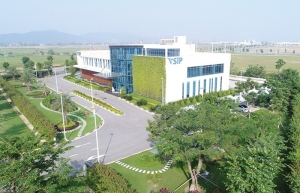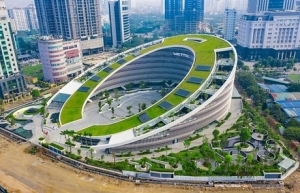Enhancing resistance of buildings to natural disasters
 |
Building Resilience Index (BRI) is an online risk warning mapping system and resilience assessment framework for the construction industry that facilitates the evaluation, development, and publication of the adaptability of the works.
"In the face of threats posed by a rapidly changing climate, it's vital to ensure that buildings are resilient to natural hazards such as cyclones, flooding, fire and landslides, especially in Vietnam's urban areas, where so many people live," said Thomas Jacobs, IFC country manager for Vietnam, Cambodia and Lao PDR. "By equipping local developers, investors, and policymakers with the Building Resilience Index, we look forward to helping strengthen the country's climate agenda, promoting a greener, sustainable, and more inclusive economy."
The BRI is included in the World Bank's (WB) 2019 Action Plan on Climate Change Adaptation and Resilience. Hotels, commercial structures, hospitals, colleges, and homes are examples of the types of initiatives that should be prioritised for BRI.
The incorporation of sustainable solutions and climate change adaptation into urban development will help ensure a secure environment for residents, according to Nguyen Cong Thinh, deputy director of the Ministry of Construction's Department of Science, Technology, and Environment. In the interim, it is key to avoid harm to property as well as contributing to Vietnam's green development blueprint for climate change adaptation and net-zero emissions.
BRI is anticipated to replicate the success of the Excellence in Design for Greater Efficiencies (EDGE) green building certification programme of the IFC, a member of the WB Group that focuses on climate change mitigation.
Since 2015, the EDGE programme has reportedly saved $4.1 million annually in electricity and water costs for 77,000 residents and reduced annual greenhouse gas emissions by 30,000 tonnes.
According to the IFC, Vietnam is one of the most vulnerable nations to climate change, with losses of up to $10 billion in 2020, or 3.2 per cent of GDP, attributable to the effects of climate change. About 300 coastal urban areas, which provide livelihoods for a swiftly urbanising and expanding population, suffer greatly because they are located in littoral areas and are susceptible to climate change-related disasters.
 | Developing sustainably with rise of green buildings In 1990, the Building Research Establishment’s Environmental Assessment Method (BREEAM) was born in the UK, marking the world’s first foundation of green building. |
 | Energy-efficient buildings on the rise in Vietnam Developing energy-efficient buildings is an inevitable trend for Vietnam to achieve its environmental objectives. |
 | Competition to promote green buildings in Binh Dinh province On October 18, the launch ceremony of the competition "Selecting potential green buildings in Binh Dinh province" took place in Quy Nhon city. |
What the stars mean:
★ Poor ★ ★ Promising ★★★ Good ★★★★ Very good ★★★★★ Exceptional
Related Contents
Latest News
More News
- The Kross ascends in Ho Chi Minh City's business heart (October 10, 2025 | 17:16)
- ESG-driven sustainability to define Vietnam’s green real estate (September 19, 2025 | 11:35)
- Tan Thuan Tower open for high value-added and innovative tenants (September 10, 2025 | 10:00)
- The new home of modern business at Hanoi's Starlake (August 19, 2025 | 08:00)
- Forum focuses on financial solutions for ESG in real estate (June 18, 2025 | 12:12)
- Frasers Property Vietnam moves towards green real estate leadership (May 08, 2025 | 11:25)
- Keppel collaborates with leading brands to enhance urban living in Vietnam (April 04, 2025 | 09:26)
- Strengthen partnership and efforts to promote zero energy buildings in Vietnam (February 26, 2025 | 17:31)
- Haus Dalat ESG real estate project holds opening ceremony (February 24, 2025 | 11:12)
- Best golfers awarded at Swing for the Kids 2024 (October 13, 2024 | 08:00)

 Tag:
Tag:





















 Mobile Version
Mobile Version